The heavy use of mobile devices by children and teens could represent a ticking time bomb, says ergonomics emeritus Professor Veikko Louhevaara. The academic from the University of Eastern Finland said that part of the problem is that our connected devices are lighter than ever, encouraging people to use them in any position. On top of that, they are small, forcing users to crane their necks and hunch their shoulders to better see what’s on the screen.
When we bend our necks and hold our smart devices in the wrong position, we may be inadvertently creating a recipe for problems in the neck and shoulder area. According to Louhevaara, the danger is especially acute in cases where youngsters adopt poor postures at an early age, setting the stage for complaints that will last a lifetime.
"A child’s body is still at a developmental stage and they can use mobile devices extensively if there is no supervision. In the current situation this doesn’t look at all good. The ingredients for [future] health issues are all there," Louhevaara remarked.
The academic said that future health problems are a realistic cause for concern. If adults don’t pay attention to how much exercise children get and how much they use mobile devices, children will literally grow up crooked, he warned.
Repeated or protracted low-intensity muscle tension will cause muscle pain and other complaints. Over time, these issues may become chronic, he noted.
"The result may be permanent loss of functionality and the ability to work," Louhevaara cautioned.
Muscles generally take a long time to recover from static and rapid work. For example, recovery from a few hours of such stress may take several hours.
Small devices, big problems
People have been suffering from ailments in the neck and shoulder region for decades, long before miniscule smart devices came on the market.
However apart from the bad posture people assume when using the technology, using the devices causes static tension, in which muscles work at low intensity - around five percent of maximum capacity. Over a long period of time this kind of tension may cause headaches and other pains.
Physiotherapist Jaakko Marjokorpi said that he has been encountering neck and shoulder ailments in increasingly younger clients, because they are adopting poor postures at an early age.
"The head is surprisingly heavy. It places a load on the lower neck and shoulders. It is also a static and long-held position," Marjokorpi pointed out.
"It is worrying to think about the kinds of shoulder problems today’s young people will have in ten years," he added.
The experts noted that youngsters in particular are in danger of future long-term health problems, simply because they have begun to use smart devices at an early age.
The combined effect of poor posture, static tension and reduced physical exercise could result in a situation where in ten years’ time there will be a generation of very sick young adults, they concluded.
